You are using an out of date browser. It may not display this or other websites correctly.
You should upgrade or use an alternative browser.
You should upgrade or use an alternative browser.
Wiim Ultra with SVS Micro 3000
- Thread starter Lagavulin
- Start date
-
- Tags
- subwoofer wiim ultra
Lagavulin
Member
- Joined
- Aug 10, 2025
- Messages
- 65
Ok this is getting more challenging than I first hoped ... the SVS 3000 Micro doesn't arrive until Tuesday so I think I'll just chill till then ... and then let the games beginWiiM don't recommend moving the device to the listening position but that is the only way to achieve the correct delay. The WiiM method might give a ballpark delay that approximately compensates for processing delays but it doesn't ensure optimum phase response around the crossover frequency at the listening position. WiiM even confirmed that further adjustments would be required after the sync was performed.
With REW you can observe the frequency response at the crossover frequency as you change the delay.
slartibartfast
Major Contributor
- Joined
- Apr 18, 2024
- Messages
- 5,342
When it was first introduced I think we all assumed it would use the same microphone as the room correction but WiiM had other ideasAs others have said it would make the process much easier if it could be done with an external mic and not the Wiim device
Since I got the WiiM device, I have been trying to acoustically integrate my woofers back into my main speakers. It's a tedious undertaking!Ok this is getting more challenging than I first hoped ... the SVS 3000 Micro doesn't arrive until Tuesday so I think I'll just chill till then ... and then let the games begin
I purchased WiiM for one simple reason: to reduce hardware.
The problem for me is the existing automatic switch-off/switch-on function of the mono amps for the woofers, which cannot be deactivated and is < 200mV for RCA. If there is too little bass energy in the signal, they switch off. These two dipole woofers are the necessary addition to my large cone dipoles with 98 dB, which run from 40Hz to 64Hz.
Below that is a monopole (20Hz-40 Hz ) that stands 2.5 metres away from the woofers, at a height of 1,5 above the floor, on the wall... unfortunately, it cannot be used with WiiM.
This is because WiiM only has a mono output.
I know the synchronisation position of the woofers to the main speakers via other DSP software, where RoomFit shows me something different.
Eddie Spaghetti
Senior Member
- Joined
- Nov 30, 2024
- Messages
- 200
It’s really not a big deal, unless you’re in a very large space and your sub and mains are at opposite ends of the room. Just keep the amp somewhere in the vicinity of your mains, and any gaps in sync will be indiscernible. When your SVS arrives, plug it in, set the crossover to 80hz in the WiiM Home app for starters, and then just take one step at a time until you’re happy with how it sounds. I think you’ll be impressed enough with what the sub adds that you’ll be content doing any further tweaking over time. Don’t overthink it - just enjoy it!Ok this is getting more challenging than I first hoped ... the SVS 3000 Micro doesn't arrive until Tuesday so I think I'll just chill till then ... and then let the games begin
Lagavulin
Member
- Joined
- Aug 10, 2025
- Messages
- 65
That would be Oboe by CPCCan hardly contain myself
First up will be Camel Power Club with Sputnik II ... followed by Jake Issac's a Hard Place live at Subfrantic
Other suggestions more than welcome
Nicholas Jaar / Album Space is only Noise / Track ColombIch kann mich kaum beherrschen
Den Anfang macht Camel Power Club mit Sputnik II ... gefolgt von Jake Issacs „A Hard Place“ live im Subfrantic.
Weitere Vorschläge sind herzlich willkommen.
And listen to how many gradations of bass there are and whether it varies tonally and at what level.
Lagavulin
Member
- Joined
- Aug 10, 2025
- Messages
- 65
So guys and gals ... the SVS 3000 Micro landed this afternoon and I've had a stab at setting it up. And yes I know it's going to take time and adjustment to get it dialed in  But can those subwoofer gurus out there cast their eyes over the attached settings and results. Please feel free to criticise and critique I won't feel in the least offended
But can those subwoofer gurus out there cast their eyes over the attached settings and results. Please feel free to criticise and critique I won't feel in the least offended 
From my listening position I used the ultra to sync the subwoofer and the tannoys ( the sub is about a foot behind offset from a corner) and having completed the process successfully I believe (if I remember correctly) the delay from the mains was 7ms and the subwoofer 19ms.
I then ran Roomfit again (to be honest I forgot to change the advanced settings from a previous run without the sub).
Anyhow this is what I got ... fire away

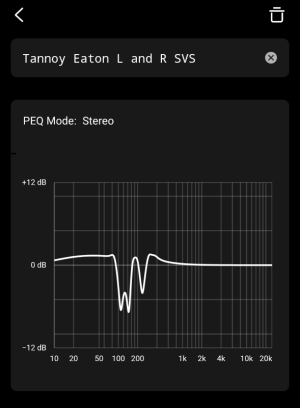
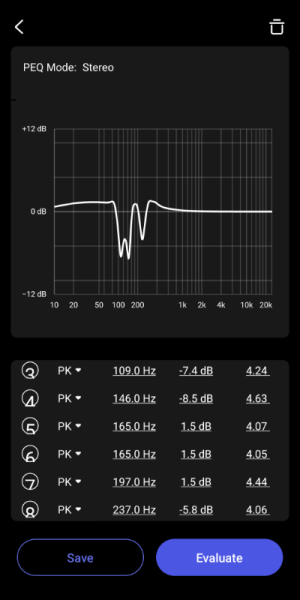

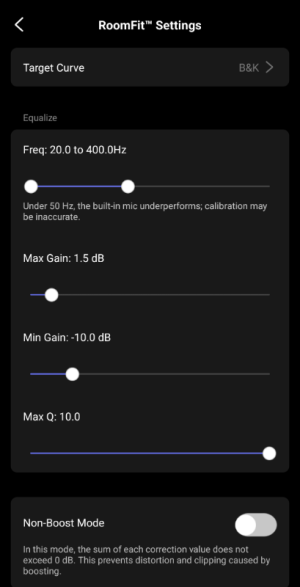
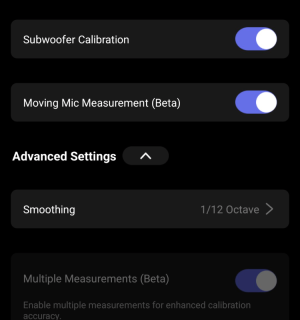
From my listening position I used the ultra to sync the subwoofer and the tannoys ( the sub is about a foot behind offset from a corner) and having completed the process successfully I believe (if I remember correctly) the delay from the mains was 7ms and the subwoofer 19ms.
I then ran Roomfit again (to be honest I forgot to change the advanced settings from a previous run without the sub).
Anyhow this is what I got ... fire away






Lagavulin
Member
- Joined
- Aug 10, 2025
- Messages
- 65
By the way I adjusted the output from 0 to +10db afterwards when listening to tracks ... to give me the kind of bass reinforcements that sounded best to my ears. Is that about oar for the course or would you expect not to have increased by so much?
Where are the RoomFit measurement results?So guys and gals ... the SVS 3000 Micro landed this afternoon and I've had a stab at setting it up. And yes I know it's going to take time and adjustment to get it dialed inBut can those subwoofer gurus out there cast their eyes over the attached settings and results. Please feel free to criticise and critique I won't feel in the least offended
From my listening position I used the ultra to sync the subwoofer and the tannoys ( the sub is about a foot behind offset from a corner) and having completed the process successfully I believe (if I remember correctly) the delay from the mains was 7ms and the subwoofer 19ms.
I then ran Roomfit again (to be honest I forgot to change the advanced settings from a previous run without the sub).
Anyhow this is what I got ... fire away
View attachment 29216View attachment 29217View attachment 29218View attachment 29219View attachment 29220View attachment 29221
As you may be aware, you can evaluate a profile by tapping the Evaluate button on the profile edit screen.Forgot to take screenshots of them ... will do it tomorrow
dominikz
Major Contributor
- Joined
- Dec 31, 2024
- Messages
- 705
Congrats on a very nice sub!So guys and gals ... the SVS 3000 Micro landed this afternoon and I've had a stab at setting it up. And yes I know it's going to take time and adjustment to get it dialed inBut can those subwoofer gurus out there cast their eyes over the attached settings and results. Please feel free to criticise and critique I won't feel in the least offended
From my listening position I used the ultra to sync the subwoofer and the tannoys ( the sub is about a foot behind offset from a corner) and having completed the process successfully I believe (if I remember correctly) the delay from the mains was 7ms and the subwoofer 19ms.
I then ran Roomfit again (to be honest I forgot to change the advanced settings from a previous run without the sub).
Anyhow this is what I got ... fire away
View attachment 29216View attachment 29217View attachment 29218View attachment 29219View attachment 29220View attachment 29221
Speaker and sub placement
It is very important for good bass quality to optimize speaker and subwoofer placement if you can, since this is the only way to reduce the effect of severe SBIR nulls (the common cause of "bass suckout") in the response.
With a standard 80Hz crossover for the sub, ideally you'd want to have the loudspeakers >1,1m away from any walls (as this moves the SBIR nulls <80Hz) with the sub right in a room corner, or at least against the wall behind the speakers (which pushes sub's SBIR null >80Hz).
With this setup the main SBIR nulls will be out of the operating range of each part of the integrated loudspeaker+sub system and you are ready to use RoomFit knock down the peaks.
If it is not possible to have speakers so deep in the room, a good alternative is to push loudspeakers close to the back wall - this moves the main SBIR null to 200Hz or higher, where it is less audibly offending and/or easier to treat acoustically.
Here you can find a more detailed explanation of the rationale behind these placement recommendations.
Subwoofer crossover, gain and phase
These would be my suggestions for settings:
- Crossover frequency: 80Hz in WiiM Home App, and disabled (or set to maximum value) in SVS app. 80Hz is a good initial value for the crossover, as it gives you an opportunity to avoid bass suckout with reasonable placement (see previous section)
- Subwoofer gain/volume: 0dB in the WiiM Home App, adjust the volume in the SVS app until bass level is subjectively comfortable.
- Note that it is better to have a bit too much bass than too little at this point, to give RoomFit headroom to work with later on.
- Subwoofer phase: start with 0°in both the WiiM Home App and SVS app.
- Run RoomFit with this value, screenshot the results, and then change phase to 180° only in the WiiM Home App, re-run RoomFit with this configuration and screenshot the results again. Keep the phase value which doesn't result in a null/dip around the crossover frequency (80Hz).
Once the above is done, you need to optimize the relative speaker/subwoofer delays.
- Option 1: The most precise way to do this is to explicitly measure the loudspeaker and subwoofer delays with REW.
- This is however not trivial to do, so I won't try to describe it here.
- Option 2: One of the easier ways to do it is to temporarily put your WiiM device in the listening position and run the automatic "Subwoofer & Speakers Sync" function.
- The reason why the WiiM device needs to go to the listening position temporarily while doing this is because unfortunately the built-in mic on the WiiM device is used for this measurement. Since you want the crossover to be optimized at the listening position, if you use this function you need to temporarily put the WiiM device where you will sit so it 'hears' what you will hear.
- Note that you'll need quite long cables for this.
- Option 3: Another way to do it, which is also relatively easy (and potentially a bit more precise, but takes longer to do), is to use the manual delay adjustment and fine tune the values until you find the optimal ones.
- Note that SVS subs with DSP should add about 6ms delay due to internal DSP processing, and that sound takes about 1ms to travel 34cm (which is a little over 1ft).
- That means that if your sub is 2ft farther away from your listening position than your speakers, the sound from the sub will be delayed by 6ms+2ms=8ms compared to the sound from the speakers. In this example a good initial value for the loudspeaker delay would be 8ms. Note that we apply the delay to the loudspeaker to compensate for the same delay in the sub. There's no need to configure the subwoofer delay at all.
- Once you find the initial loudspeaker delay, you would then re-run RoomFit multiple times with loudspeaker delay values iterated through all values ±3ms from initial value in 1ms increments, and see which one gives you the smoothest response around the subwoofer crossover (80Hz is assumed to be the crossover frequency).
- If we take 8ms loudspeaker delay example as the initial value, this means you'd evaluate the response with each of 5ms, 6ms, 7ms... all the way up to 11ms loudspeaker delay.
- Here you can see one example of this process (in this example values between 9ms and 11ms loudspeaker delay improved the crossover region response in the right channel, compared to lower delay values which had a dip).
RoomFit
I'd recommend to start with these setting:
- Target: B&K
- Frequency: 20Hz-300Hz
- Smoothing: 1/12
- No-Boost Mode: enabled
- Min Gain: -12dB
- Max Gain: +12dB
- Max Q: 10
- Moving Mic Measurement: disabled
- Multiple Measurements: disabled
- Select "Individual Channel RoomFit" when option is presented
Note that these are all just initial guidelines to get you started - due to specifics of every environment and setup it can happen that additional adjustments may be needed to achieve optimal results.
Hope this helps and good luck!
Last edited:
Lagavulin
Member
- Joined
- Aug 10, 2025
- Messages
- 65
Really thanks a lot for this and your suggestions ... I am going to try them out over the next day or two.Congrats on a very nice sub!
Speaker and sub placement
It is very important for good bass quality to optimize speaker and subwoofer placement if you can, since this is the only way to reduce the effect of severe SBIR nulls (the common cause of "bass suckout") in the response.
With a standard 80Hz crossover for the sub, ideally you'd want to have the loudspeakers >1,1m away from any walls (as this moves the SBIR nulls <80Hz) with the sub right in a room corner, or at least against the wall behind the speakers (which pushes sub's SBIR null >80Hz).
With this setup the main SBIR nulls will be out of the operating range of each part of the integrated loudspeaker+sub system and you are ready to use RoomFit knock down the peaks.
If it is not possible to have speakers so deep in the room, a good alternative is to push loudspeakers close to the back wall - this moves the main SBIR null to 200Hz or higher, where it is less audibly offending and/or easier to treat acoustically.
Here you can find a more detailed explanation of the rationale behind these placement recommendations.
Subwoofer crossover, gain and phase
These would be my suggestions for settings:
Speaker and sub sync
- Crossover frequency: 80Hz in WiiM Home App, and disabled (or set to maximum value) in SVS app. 80Hz is a good initial value for the crossover, as it gives you an opportunity to avoid bass suckout with reasonable placement (see previous section)
- Subwoofer gain/volume: 0dB in the WiiM Home App, adjust the volume in the SVS app until bass level is subjectively comfortable.
- Note that it is better to have a bit too much bass than too little at this point, to give RoomFit headroom to work with later on.
- Subwoofer phase: start with 0°in both the WiiM Home App and SVS app.
- Run RoomFit with this value, screenshot the results, and then change phase to 180° only in the WiiM Home App, re-run RoomFit with this configuration and screenshot the results again. Keep the phase value which doesn't result in a null/dip around the crossover frequency (80Hz).
Once the above is done, you need to optimize the relative speaker/subwoofer delays.
Good news is that once these steps are done, you are in a good position to run RoomFit (for real this time)!
- Option 1: The most precise way to do this is to explicitly measure the loudspeaker and subwoofer delays with REW.
- This is however not trivial to do, so I won't try to describe it here.
- Option 2: One of the easier ways to do it is to temporarily put your WiiM device in the listening position and run the automatic "Subwoofer & Speakers Sync" function.
- The reason why the WiiM device needs to go to the listening position temporarily while doing this is because unfortunately the built-in mic on the WiiM device is used for this measurement. Since you want the crossover to be optimized at the listening position, if you use this function you need to temporarily put the WiiM device where you will sit so it 'hears' what you will hear.
- Note that you'll need quite long cables for this.
- Option 3: Another way to do it, which is also relatively easy (and potentially a bit more precise, but takes longer to do), is to use the manual delay adjustment and fine tune the values until you find the optimal ones.
- Note that SVS subs with DSP should add about 6ms delay due to internal DSP processing, and that sound takes about 1ms to travel 34cm (which is a little over 1ft).
- That means that if your sub is 2ft farther away from your listening position than your speakers, the sound from the sub will be delayed by 6ms+2ms=8ms compared to the sound from the speakers. In this example a good initial value for the loudspeaker delay would be 8ms. Note that we apply the delay to the loudspeaker to compensate for the same delay in the sub. There's no need to configure the subwoofer delay at all.
- Once you find the initial loudspeaker delay, you would then re-run RoomFit multiple times with loudspeaker delay values iterated through all values ±3ms from initial value in 1ms increments, and see which one gives you the smoothest response around the subwoofer crossover (80Hz is assumed to be the crossover frequency).
- If we take 8ms loudspeaker delay example as the initial value, this means you'd evaluate the response with each of 5ms, 6ms, 7ms... all the way up to 11ms loudspeaker delay.
- Here you can see one example of this process (in this example values between 9ms and 11ms loudspeaker delay improved the crossover region response in the right channel, compared to lower delay values which had a dip).
RoomFit
I'd recommend to start with these setting:
Use an external USB measurement microphone if you have one (e.g. miniDSP UMIK-1 or Dayton iMM-6c), and load the corresponding individual calibration file in RoomFit.
- Target: B&K
- Frequency: 20Hz-300Hz
- Smoothing: 1/12
- No-Boost Mode: enabled
- Min Gain: -12dB
- Max Gain: +12dB
- Max Q: 10
- Moving Mic Measurement: disabled
- Multiple Measurements: disabled
- Select "Individual Channel RoomFit" when option is presented
Note that these are all just initial guidelines to get you started - due to specifics of every environment and setup it can happen that additional adjustments may be needed to achieve optimal results.
Hope this helps and good luck!
In the meantime I ran RoomFit again to get the graphs as @Wiimer suggested and I haven't completely followed your suggestions. I will post them anyway as they look a bit strange to me ...
Lagavulin
Member
- Joined
- Aug 10, 2025
- Messages
- 65
Sorry if I'm boring people with all the screenshots ... be kind as I'm trying but I really am a novice when it comes to sub integration and reading frequency responses.
I ran RoomFit again but I tweaked a couple of settings ...
1. I ran it full frequency range 20 - 20,000Hz instead of 20-400Hz.
2. I changed the sub output from +10db to zero.
Having run RoomFit I followed through with the evaluation and finally applied it to the earlier profile. I found that I still had to apply the +10db to the sub output to get any sort of bass level. I'm not convinced it sounds as good as I had it yesterday ...
What do people think? Apologies if I've got the screenshots out of order ... I can't see a preview button.
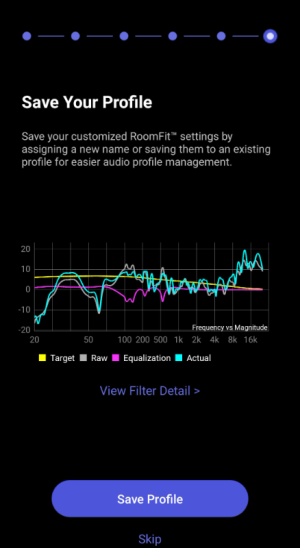

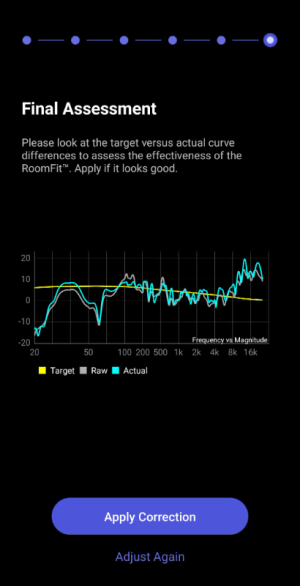
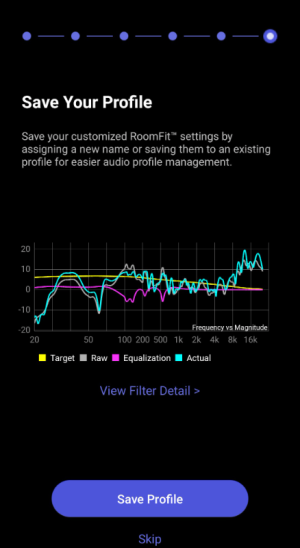

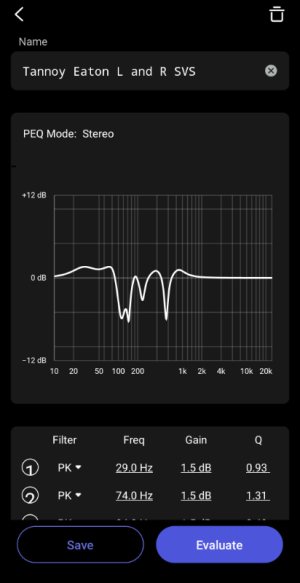
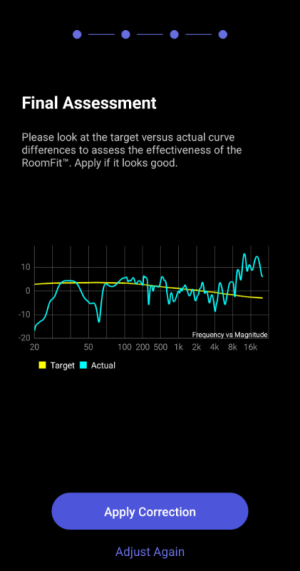
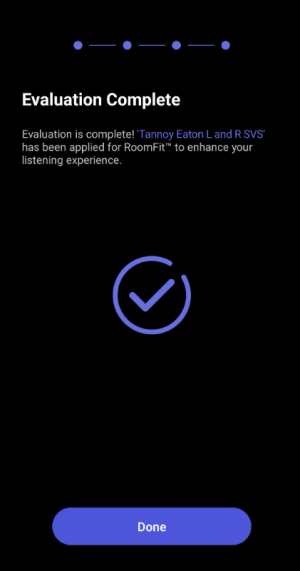
I ran RoomFit again but I tweaked a couple of settings ...
1. I ran it full frequency range 20 - 20,000Hz instead of 20-400Hz.
2. I changed the sub output from +10db to zero.
Having run RoomFit I followed through with the evaluation and finally applied it to the earlier profile. I found that I still had to apply the +10db to the sub output to get any sort of bass level. I'm not convinced it sounds as good as I had it yesterday ...
What do people think? Apologies if I've got the screenshots out of order ... I can't see a preview button.








dominikz
Major Contributor
- Joined
- Dec 31, 2024
- Messages
- 705
The peak above 8 kHz is because I assume you are using the phone built-in microphone, in which case you can disregard it.Sorry if I'm boring people with all the screenshots ... be kind as I'm trying but I really am a novice when it comes to sub integration and reading frequency responses.
I ran RoomFit again but I tweaked a couple of settings ...
1. I ran it full frequency range 20 - 20,000Hz instead of 20-400Hz.
2. I changed the sub output from +10db to zero.
Having run RoomFit I followed through with the evaluation and finally applied it to the earlier profile. I found that I still had to apply the +10db to the sub output to get any sort of bass level. I'm not convinced it sounds as good as I had it yesterday ...
What do people think? Apologies if I've got the screenshots out of order ... I can't see a preview button.
View attachment 29288View attachment 29290View attachment 29291View attachment 29292View attachment 29294View attachment 29293View attachment 29296View attachment 29295
The hole around 60Hz is probably a phase cancelation between the sub and speakers.
You should be able to fix this by following some of the steps from my previous post.
The rest doesn't look that bad to me, a solid starting point IMHO!
Last edited:
Eddie Spaghetti
Senior Member
- Joined
- Nov 30, 2024
- Messages
- 200
I’m no expert by any stretch, but I have messed with a few subs in different applications, and I’m a bit baffled by the need to boost the sub level so much. I have a SB-1000 Pro, rated 325 watts RMS, that’s carrying the bass perfectly over a pair of Paradigm Monitor SE 6000F’s, which are pretty high sensitivity speakers. Zero sub boost from the WiiM app, and just + .1 db in the SVS app’s EQ down at 20hz - that’s it. Putting the Amp Ultra volume at about 50% will rattle the walls. The 3000 Micro is rated at 800w - it should be blowing out your eardrums. What is your volume level on the sub itself? And I may have missed it, but what’s your crossover set to in your last Room Fit run?Sorry if I'm boring people with all the screenshots ... be kind as I'm trying but I really am a novice when it comes to sub integration and reading frequency responses.
I ran RoomFit again but I tweaked a couple of settings ...
1. I ran it full frequency range 20 - 20,000Hz instead of 20-400Hz.
2. I changed the sub output from +10db to zero.
Having run RoomFit I followed through with the evaluation and finally applied it to the earlier profile. I found that I still had to apply the +10db to the sub output to get any sort of bass level. I'm not convinced it sounds as good as I had it yesterday ...
What do people think? Apologies if I've got the screenshots out of order ... I can't see a preview button.
View attachment 29288View attachment 29290View attachment 29291View attachment 29292View attachment 29294View attachment 29293View attachment 29296View attachment 29295
Lagavulin
Member
- Joined
- Aug 10, 2025
- Messages
- 65
Good point ... just checked the sub volume level in the SVS app and it was still on the -30db that I had set it to when syncing with the Tannoys. That unless I totally misunderstood what the WiiM tutorial was saying about syncing (i.e. set at the midpoint of the sub output which has a range of 0 to -60db in the SVS app ).I’m no expert by any stretch, but I have messed with a few subs in different applications, and I’m a bit baffled by the need to boost the sub level so much. I have a SB-1000 Pro, rated 325 watts RMS, that’s carrying the bass perfectly over a pair of Paradigm Monitor SE 6000F’s, which are pretty high sensitivity speakers. Zero sub boost from the WiiM app, and just + .1 db in the SVS app’s EQ down at 20hz - that’s it. Putting the Amp Ultra volume at about 50% will rattle the walls. The 3000 Micro is rated at 800w - it should be blowing out your eardrums. What is your volume level on the sub itself? And I may have missed it, but what’s your crossover set to in your last Room Fit run?
I never changed this and used the WiiM to set the volume as stated in the tutorial. Presumably this is wrong? What is the correct way of controlling the volume of the sub? A mixture of the two?
Crossover was set at 55Hz as the Tannoys go down to 40Hz and the WiiM app suggested crossing at between 10 and 15 Hz above the main speakers.
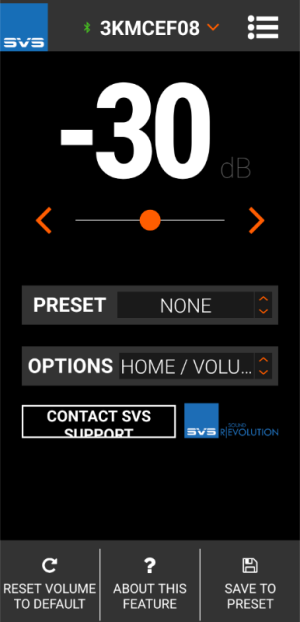
Eddie Spaghetti
Senior Member
- Joined
- Nov 30, 2024
- Messages
- 200
I’d try maxing the volume at the sub - I saw that recommended for mine in a few different places - and control the bass level from the WiiM app. And I’d try pushing the crossover up to 80. Remember to set your sub gain in the WiiM app back to 0 before the next assessment, and don’t be surprised if you have to lower it further after a listen. The Tannoys may be rated down to 40 hz, but they’re working hard down there. The more lower frequencies you can push off to the sub (within reason) is that much extra work your mains don’t have to do, and the better they’ll sound handling mids and highs. 80 hz is well under your sub’s high end (240 hz, I believe), so that should be close to the sweet spot between sub and mains.Good point ... just checked the sub volume level in the SVS app and it was still on the -30db that I had set it to when syncing with the Tannoys. That unless I totally misunderstood what the WiiM tutorial was saying about syncing (i.e. set at the midpoint of the sub output which has a range of 0 to -60db in the SVS app ).
I never changed this and used the WiiM to set the volume as stated in the tutorial. Presumably this is wrong? What is the correct way of controlling the volume of the sub? A mixture of the two?
Crossover was set at 55Hz as the Tannoys go down to 40Hz and the WiiM app suggested crossing at between 10 and 15 Hz above the main speakers.
View attachment 29313
Just for reference, my Paradigms have a low frequency response of 53 hz. I started with the crossover at 80, then tried 120. While there wasn’t any discernible difference in the bass, the Paradigms seem a little happier being just that tad further away from their low end, so there at 120 it stays.
Similar threads
- Replies
- 0
- Views
- 236
- Question
- Replies
- 20
- Views
- 1K
- Replies
- 6
- Views
- 281
- Replies
- 3
- Views
- 583
- Replies
- 0
- Views
- 271
